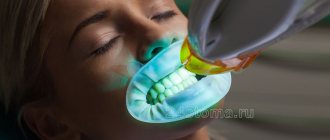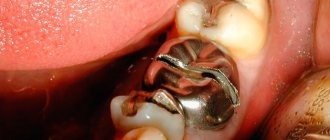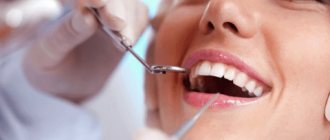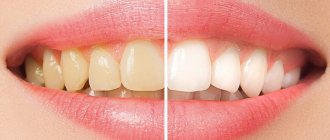Teeth whitening in childhood – how safe and justified?
When a child’s tooth enamel begins to darken, this may indicate insufficient oral hygiene or the development of a dental disease. But teeth can change color for other reasons beyond our control, for example, as a result of genetic predisposition. Due to such circumstances, the child may develop psychological complexes and self-doubt. Therefore, some parents have a completely reasonable question: is it possible to whiten children’s teeth and how safe is it? You will find answers to these and other questions later in this article.
Is it possible to whiten teeth as a child?
Preparing for the whitening procedure
Do not underestimate the importance of the preparatory stage, which must necessarily precede the lightening procedure. It is very important because it allows you to:
- ensure safety and eliminate the risk of pain;
- achieve maximum aesthetic effect.
Preparatory activities include the following dental procedures:
- Sanitation of the oral cavity is the identification and elimination of any pathological processes in the oral cavity: from the treatment of caries to the improvement of gums. This is the competence of the Edkar dentist-therapist.
- Professional teeth cleaning, including remineralization therapy, which will strengthen the enamel and reduce its sensitivity. This hygiene procedure is performed by our hygienist.
Only after all of the above procedures can you begin teeth whitening.
Why does a child's teeth darken?
Tooth enamel can darken for various reasons. At the same time, it can noticeably turn yellow or even turn light brown. Of course, this state of affairs can negatively affect not only oral health, but also the psychological state of the child. So why does enamel change color? Here are some common reasons for this unpleasant phenomenon:
- uncontrolled consumption of sweets and fast carbohydrates: foods high in sugar are the most common cause of the development of caries in childhood1. They contribute to the formation of a bacterial film on the surface of the enamel, which very quickly turns into hard dental deposits. All this leads to its inevitable darkening,
Caries leads to discoloration of teeth - constant consumption of food with pigments: this includes coloring drinks such as tea, coffee, sweet soda with dyes. The latter not only contribute to a change in the color of the enamel, but also lead to the gradual destruction of dental tissues, since the composition of such liquids contains too many sugars and acids,
- genetics: according to experts, quite often dark enamel becomes a consequence of genetic predisposition, and then dealing with the problem becomes much more difficult,
- tooth injury: the presence of microcracks, scratches, chips, carious plaque and dental deposits on the enamel - all these factors have a direct impact on the condition and, accordingly, the color of the enamel.
“When my child’s teeth became very dark, I immediately decided that he wasn’t brushing. I started urging him to brush his teeth in front of me every morning and evening before bed. I excluded sugar and flour from my diet, of course, as much as possible. But nothing helped. And only at the dentist’s appointment it turned out that it was all a matter of genetics. The teeth themselves are very susceptible to caries, and even dark. We were booked in for professional cleaning, but were told to hold off on bleaching. Such procedures are not performed on children, so they will have to wait until they reach adulthood.”
Alyonka_33, Omsk, from correspondence on the woman.ru forum
Keep in mind that if there is even the slightest damage to tooth enamel, it is prohibited to use any whitening methods, especially at home. Otherwise, the aggressive effects of whitening agents may even lead to complete destruction of the outer protective layer of the teeth. Therefore, before carrying out such a procedure, it is imperative to consult with a specialist.
Important! As for children, it is generally not allowed to use any methods of lightening enamel without the permission of the dentist. Therefore, the answer to the question “is it possible to whiten teeth in childhood” will, on the one hand, be categorical (the use of chemicals is prohibited), but, on the other hand, it will be positive – there is a professional cleaning method.
Repeated laser correction and indications for it
In rare cases, such a procedure does not bring the desired result , but not because it is impossible to correct the situation at all, but because the violations are too strong , which cannot be eliminated at once.
It is worth noting! Sometimes it happens that due to the fault of specialists, incorrect correction parameters are set.
Alternatively, healing occurs poorly and vision is not restored after surgery to the required values due to the fault of the patient himself, who does not comply with the doctor’s instructions during the rehabilitation period.
The opposite situation is also possible - healing is too intense and when correcting myopia, vision turns into farsightedness (and vice versa).
In all these cases, repeated or additional laser correction is necessary .
Depending on the speed of healing, it can be performed 3-6 months after the initial operation.
But in such cases, everything is individual and the timing depends on how long it takes for the final stabilization of vision to occur (and this sometimes happens after 1-1.5 months).
Technically, the primary and additional procedures are no different .
But the shorter the time interval between interventions, the greater the likelihood that the corneal flap has not yet fully healed, and a new incision does not need to be made to move it.
Professional hygiene complex - an option on how to make children's tooth enamel lighter
So, is it possible to whiten a child’s teeth and how to do it without damaging the fragile enamel? In fact, what we usually mean by bleaching, that is, the use of aggressive chemicals, is contraindicated in children. This raises a logical question: at what age can one begin to carry out such procedures? In dental centers, this type of service is offered to patients only from 15-16 years of age, and in some situations even from 18 years of age. However, there is another, alternative option - regular, but very high-quality teeth cleaning. Let's look at this method.
So, in addition to classic whitening (photo, chemical or laser), modern dentistry offers the opportunity to steal electrical energy to clean the enamel of plaque and plaque in a gentle way. Using hardware techniques, you can lighten your teeth a couple of shades, but if the cause of dark enamel is genetics, this method is unlikely to make it noticeably lighter. On the other hand, this is not just effective, but mandatory prevention of caries development, which is carried out for children starting from 7-8 years old and even younger. When a very young patient finds himself in the dental chair, he may be offered gentle manual cleaning.
In childhood, only gentle brushing of teeth is allowed.
Cleaning using the Air Flow device has become widespread today. In this case, we are not talking about an aggressive chemical effect, but about high-quality cleansing of the enamel from bacteria and accumulations of food debris. The device works as follows: compressed air is supplied to the tip under high pressure along with baking soda. Treatment of the surface of the teeth with a powerful jet allows you to clean even the most inaccessible places. In order to give the effect of freshness, essential oil or lemon essence is often added to the mixture.
On a note! Ultrasonic cleaning before the age of 5-7 years is also prohibited. Air Flo cannot be used if the child has a hypersensitivity to citrus fruits or mint - there is a high risk of developing an allergic reaction.
Why classic whitening is not performed in childhood
So what’s wrong with classic professional whitening and why aren’t similar procedures performed in children? The thing is that a child’s tooth enamel is characterized by increased fragility and susceptibility to any kind of external irritants. And traditional methods of lightening it precisely involve a rather aggressive effect on the surface of the teeth. Here are some good reasons that do not allow you to whiten children's enamel even in the dentist's office:
- thinning of the enamel: as a result of exposure to chemicals, ultraviolet radiation or laser, the density of the enamel is noticeably reduced and its structure is disrupted. When it comes to a child, the protective layer of the teeth may not be able to withstand it at all. As a result, the risk of developing caries and other dental diseases greatly increases,
- demineralization: during the procedure, rapid destruction of minerals is observed, and this, in turn, greatly weakens the teeth. Even adult patients after whitening are recommended to undergo a remineralization procedure,
- increased enamel sensitivity: teeth begin to react sharply to hot and cold, as well as to acidic foods, and this is an obvious drawback of professional whitening. The enamel becomes much thinner, which significantly increases the likelihood of problems with teeth and enamel pigmentation in particular.
- risk of burns: using ultraviolet light to lighten tooth enamel can cause a serious burn on the mucous membrane. At the same time, dental tissues also suffer greatly from heating.
Aggressive whitening can lead to thinning and demineralization of the enamel.
Obviously, the only option to make the enamel of children's teeth a little lighter is to schedule a professional cleaning at the dentist's office. If we are talking about a child, then this is the safest and preferable option, which allows you to make the enamel a couple of tones lighter. And remember: independent attempts to lighten children’s teeth using folk remedies are fraught with serious problems, including complete destruction of the enamel. This kind of procedure is best left to professionals.
- According to WHO research results.
Are artificial crowns and fillings bleached?
No. No crowns or fillings can be whitened using any method. Therefore, after lightening your teeth, you will have to replace any restorations with those that are visible when you smile and talk. If your teeth have caries or leaky fillings, then before whitening a temporary restoration is made, which, after all lightening procedures are completed, is changed to a permanent one, taking into account the resulting shade of the teeth.
This photo shows that the plastic temporary crown, originally made to match the color of the neighboring teeth, after the whitening procedure stands out strongly against the background of its lighter neighbors
These are the main questions about teeth whitening that I have encountered. This article will be updated as new ones appear. If you are thinking about this fashionable procedure, remember that beautiful teeth are, first of all, healthy teeth. And in attempts to improve their appearance, you should not harm them with dubious methods or independent exercises using improvised means.










